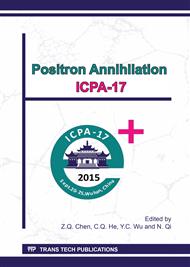p.231
p.237
p.241
p.245
p.249
p.257
p.261
p.265
p.269
Microstructure and Defects of MgO/ZrO2 Nanocrystals Investigated by Positron Annihilation Spectroscopy
Abstract:
Pure MgO, ZrO2 and mixture MgO/ZrO2 nanocrystals were annealed in air from 100 to 1200°C. Variation of the microstructure and defects was investigated by positron lifetime spectroscopy and X-ray diffraction. The experiment results showed that the average positron lifetime of mixture MgO/ZrO2 was more larger than that of single phase MgO and ZrO2, and decreased with the increasing annealing temperature. Thermal annealing below 600°C, the movement of grain boundaries mainly led a reduce of the number of microvoids, and vacancy defects began to recover due to the growth of MgO nanoparticles after annealing between 600 to 900°C. Furthermore, ZrO2 nanoparticles began to grow above 900°C, meanwhile the recovery of vacancy and vacancy clusters in MgO/ZrO2 nanoparticles are restrained because of synergic effect between MgO and ZrO2 nanoparticles.
Info:
Periodical:
Pages:
249-253
Citation:
Online since:
March 2017
Authors:
Keywords:
Price:
Сopyright:
© 2016 Trans Tech Publications Ltd. All Rights Reserved
Share:
Citation:


